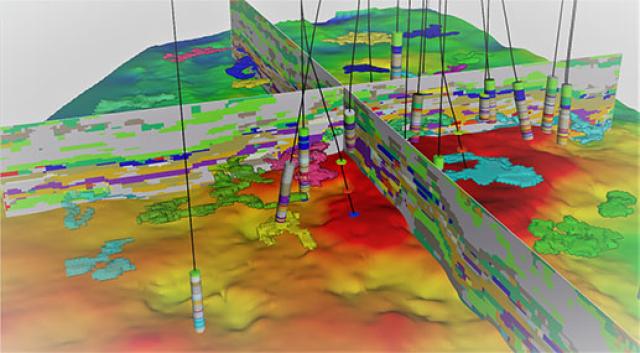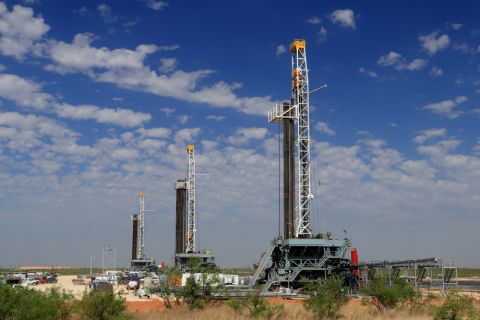
Inline and crossline display of most likely facies distribution, with a reservoir base horizon structure. The facies distribution is estimated from facies logs and prestack time migrated gathers. The result matches the wells. Geobodies isolate high probability reservoir zones. (Image courtesy of Paradigm)
Learn more about Hart Energy Conferences
Get our latest conference schedules, updates and insights straight to your inbox.
In the early days of oil and gas exploration, geoscientists suffered from a lack of data, and subsurface knowledge was often experimental and intuitive. Today, geoscientists face the opposite problem, as advancements in seismic acquisition and geophysical processing influence our knowledge, from basic geology to a detailed understanding of subsurface phenomena.
In addition to advances in technology, the amount of available data, especially prestack data, continues to increase exponentially. The challenge is how to make optimal use of this enormous amount of data while assuring its reconciliation with other data types acquired at different resolutions, such as well information.
An increasingly effective method for handling Big Data, as it is commonly called, is machine learning. As with all other breakthrough technologies, machine learning is revolutionizing our lives in areas as disparate as self-driving cars and facial recognition algorithms that now score higher recognition scores than live human viewers. Due to the enormous size and volume of data in the industry, seismic interpretation can benefit more than other market segments from the power of machine learning.
Paradigm 17, the recently-released solution suite from Paradigm, delivers several machine learning techniques fully integrated into the interpretation platform. Alongside waveform neural network classification, Paradigm 17 introduces a machine learning-based technology known as rock type classification based on Democratic Neural Network Association (DNNA).
Paradigm 17 provides interpreters with tools to help detect patterns in the seismic data to create new assets that improve the interpretation process. In Paradigm 17 waveform classification, in addition to being one of the most efficient stratigraphic analysis tools available, provides the ability to calibrate facies maps to wedge and fluid substitution traces. This process then generates maps that can be used for quantitative seismic interpretation.
Incorporated in the Paradigm SeisEarth integrated canvas, rock type classification based on DNNA technology is used to reconcile 3-D seismic data with well data to predict the formation away from the wellbore, facies or rock types determined from logs. Using several neural networks running in parallel that simultaneously learn from the same dataset using different strategies, the outcome of this workflow is a probabilistic facies model that provides a reliable and realistic description of any type of reservoir. It predicts not only the most likely facies distribution and associated maximum probability but the probability relative to each facies. The different studies where this technology has been used demonstrate that the results obtained show higher resolution than conventional approaches.
As shown in Figure 1, beds below 5 m (16 ft) are resolved, and the level of uncertainty of this prediction is quantified through measuring classification probability. This method optimizes the use of prestack and post-stack seismic data along with well data using an innovative supervised process. It delivers a calibrated and upscaled facies distribution that can be used directly in any reservoir characterization and modeling workflow. The most likely facies distribution can be used directly as a property in reservoir modeling or as a constraint for property modeling. On the other hand, the probabilities associated with each facies are directly input to simulate different scenarios of facies distribution. This approach brings seismic into the process of facies simulation, enhancing confidence in the results.
The above techniques complement traditional seismic-driven reservoir characterization workflows by integrating the probabilistic facies model into the process. This approach is especially effective in complex reservoirs in both conventional and unconventional plays and enhances geoscientists’ confidence in any decision-making process.
For unconventional reservoirs, this workflow can be used to predict the distribution of geomechanical properties, providing a new tool to aid in the optimization of the completion program.
Recommended Reading
The Need for Speed in Oil, Gas Operations
2024-03-22 - NobleAI uses “science-based AI” to improve operator decision making and speed up oil and gas developments.
E&P Highlights: April 15, 2024
2024-04-15 - Here’s a roundup of the latest E&P headlines, including an ultra-deepwater discovery and new contract awards.
TPH: Lower 48 to Shed Rigs Through 3Q Before Gas Plays Rebound
2024-03-13 - TPH&Co. analysis shows the Permian Basin will lose rigs near term, but as activity in gassy plays ticks up later this year, the Permian may be headed towards muted activity into 2025.
US Drillers Add Most Oil, Gas Rigs in a Week Since September
2024-03-15 - The oil and gas rig count, an early indicator of future output, rose by seven to 629 in the week to March 15.
US Drillers Add Most Oil Rigs in a Week Since November
2024-02-23 - The oil and gas rig count rose by five to 626 in the week to Feb. 23



